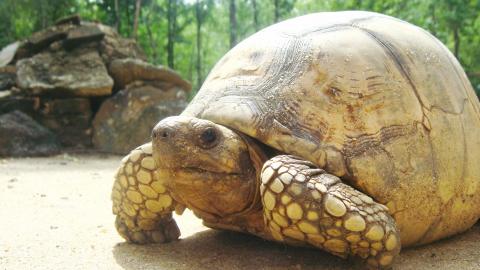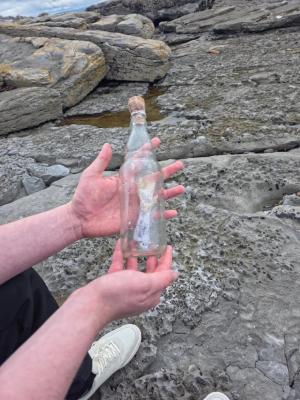The Taipei Zoo said it is working with global partners to prevent an endangered tortoise species from sharing the same fate as Lonesome George, the last of a subspecies of tortoise that died last week on June 24.
“Lonesome George is in the past now. The pressing issue is to prevent the tragedy from happening again to other tortoises threatened with extinction,” said Chang Ming-hsiung (張明雄), chief executive of the zoo’s Conservation and Research Center.
Lonesome George, a Pinta Island giant tortoise (Chelonoidis nigra abingdonii) that lived in the Galapagos Islands, died at the age of 100, prompting worldwide mourning over the beloved conservation icon.

Photo courtesy of Taipei Zoo
The subspecies is believed to have become extinct because Lonesome George, which had been kept in captivity in Galapagos National Park since the 1970s, failed to leave any offspring.
Although it caused consternation among conservationists, the tortoise’s demise may help other species survive.
It has prompted the Taipei Zoo to reflect on its conservation strategy for the endangered Burmese star tortoise. The zoo has 19 of the turtles, which were found in the 1990s in Taiwan after being illegally smuggled into the country for the pet or medicine markets.
That is 6.3 percent of the estimated global population of 300 for a species ranked 11th in the Turtle Conservation Coalition’s report last year entitled Turtles In Trouble: The World’s Top 25+ Endangered Tortoises and Freshwater Turtles.
Speaking at an international workshop the zoo held last week to discuss ways of restoring tortoise populations, Donal Boyer, curator of herpetology at the Bronx Zoo in New York, said the case of Lonesome George pointed to the need for conservationists to work more closely together to establish captive breeding programs.
Chang agreed, saying that a successful partnership would mean frequent exchanges of information on details such as the reptile’s habits and behavior as well as new high-tech breeding methods.
Chang cited as an example the time when the Taipei Zoo contacted the Behler Chelonian Conservation Center in California with the help of the Bronx Zoo in 2006 for advice on lifting the hatchling survival rate of its Burmese star tortoises.
As a result of the partnership, the survival rate improved from under 10 percent to 70 percent.
Another benefit of a strong network is the exchange of robust genetic diversity to increase the group’s chances for survival, said Gerald Kuchling, a conservationist at the University of West Australia.
Chang said these multinational efforts are aimed at creating “recovery houses” for the tortoises, natural sanctuaries that imitate the animal’s original habitat.
He said the Taipei Zoo’s next step would be to work with the Bronx Zoo-based Wildlife Conservation Society to prepare its Burmese star tortoises for reintroduction into such recovery houses in Myanmar next year.
However, the ultimate goal is to restore natural habitats so the creatures can be released into the wild.
“The Burmese star tortoises deserve to live in their original habitats in Myanmar,” Chang said. “They deserve to live in the wild instead of dying alone in zoos.”

‘NON-RED’: Taiwan and Ireland should work together to foster a values-driven, democratic economic system, leveraging their complementary industries, Lai said President William Lai (賴清德) yesterday expressed hopes for closer ties between Taiwan and Ireland, and that both countries could collaborate to create a values-driven, democracy-centered economic system. He made the remarks while meeting with an Irish cross-party parliamentary delegation visiting Taiwan. The delegation, led by John McGuinness, deputy speaker of the Irish house of representatives, known as the Dail, includes Irish lawmakers Malcolm Byrne, Barry Ward, Ken O’Flynn and Teresa Costello. McGuinness, who chairs the Ireland-Taiwan Parliamentary Friendship Association, is a friend of Taiwan, and under his leadership, the association’s influence has grown over the past few years, Lai said. Ireland is

FINAL COUNTDOWN: About 50,000 attended a pro-recall rally yesterday, while the KMT and the TPP plan to rally against the recall votes today Democracy activists, together with arts and education representatives, yesterday organized a motorcade, while thousands gathered on Ketagalan Boulevard in Taipei in the evening in support of tomorrow’s recall votes. Recall votes for 24 Chinese Nationalist Party (KMT) lawmakers and suspended Hsinchu City mayor Ann Kao (高虹安) are to be held tomorrow, while recall votes for seven other KMT lawmakers are scheduled for Aug. 23. The afternoon motorcade was led by the Spring Breeze Culture and Arts Foundation, the Tyzen Hsiao Foundation and the Friends of Lee Teng-hui Association, and was joined by delegates from the Taiwan Statebuilding Party and the Taiwan Solidarity

An SOS message in a bottle has been found in Ireland that is believed to have come from the Taiwanese captain of fishing vessel Yong Yu Sing No. 18 (永裕興18號), who has been missing without a trace for over four years, along with nine Indonesian crew members. The vessel, registered to Suao (蘇澳), went missing near Hawaii on Dec. 30, 2020. The ship has since been recovered, but the 10 crew members have never been found. The captain, surnamed Lee (李), is believed to have signed the note with his name. A post appeared on Reddit on Tuesday after a man

Instead of threatening tariffs on Taiwan-made chips, the US should try to reinforce cooperation with Taiwan on semiconductor development to take on challenges from the People’s Republic of China (PRC), a Taiwanese think tank said. The administration of US President Donald Trump has threatened to impose across-the-board import duties of 32 percent on Taiwan-made goods and levy a separate tariff on semiconductors, which Taiwan is hoping to avoid. The Research Institute for Democracy, Society, and Emerging Technology (DSET), a National Science and Technology Council think tank, said that US efforts should focus on containing China’s semiconductor rise rather than impairing Taiwan. “Without